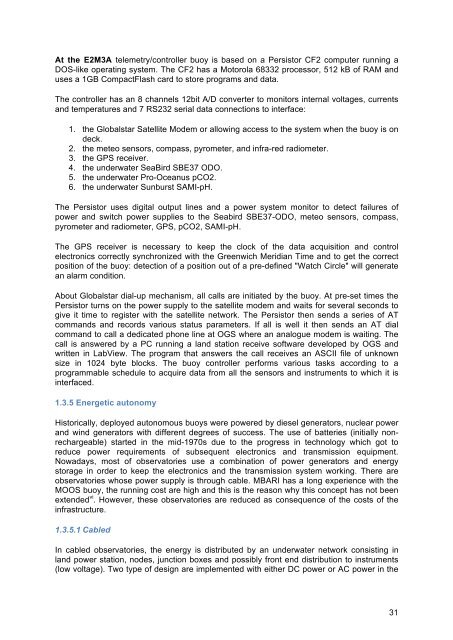Handbook of best practices
Handbook%20of%20best%20practices
Handbook%20of%20best%20practices
You also want an ePaper? Increase the reach of your titles
YUMPU automatically turns print PDFs into web optimized ePapers that Google loves.
At the E2M3A telemetry/controller buoy is based on a Persistor CF2 computer running a<br />
DOS-like operating system. The CF2 has a Motorola 68332 processor, 512 kB <strong>of</strong> RAM and<br />
uses a 1GB CompactFlash card to store programs and data.<br />
The controller has an 8 channels 12bit A/D converter to monitors internal voltages, currents<br />
and temperatures and 7 RS232 serial data connections to interface:<br />
1. the Globalstar Satellite Modem or allowing access to the system when the buoy is on<br />
deck.<br />
2. the meteo sensors, compass, pyrometer, and infra-red radiometer.<br />
3. the GPS receiver.<br />
4. the underwater SeaBird SBE37 ODO.<br />
5. the underwater Pro-Oceanus pCO2.<br />
6. the underwater Sunburst SAMI-pH.<br />
The Persistor uses digital output lines and a power system monitor to detect failures <strong>of</strong><br />
power and switch power supplies to the Seabird SBE37-ODO, meteo sensors, compass,<br />
pyrometer and radiometer, GPS, pCO2, SAMI-pH.<br />
The GPS receiver is necessary to keep the clock <strong>of</strong> the data acquisition and control<br />
electronics correctly synchronized with the Greenwich Meridian Time and to get the correct<br />
position <strong>of</strong> the buoy: detection <strong>of</strong> a position out <strong>of</strong> a pre-defined "Watch Circle" will generate<br />
an alarm condition.<br />
About Globalstar dial-up mechanism, all calls are initiated by the buoy. At pre-set times the<br />
Persistor turns on the power supply to the satellite modem and waits for several seconds to<br />
give it time to register with the satellite network. The Persistor then sends a series <strong>of</strong> AT<br />
commands and records various status parameters. If all is well it then sends an AT dial<br />
command to call a dedicated phone line at OGS where an analogue modem is waiting. The<br />
call is answered by a PC running a land station receive s<strong>of</strong>tware developed by OGS and<br />
written in LabView. The program that answers the call receives an ASCII file <strong>of</strong> unknown<br />
size in 1024 byte blocks. The buoy controller performs various tasks according to a<br />
programmable schedule to acquire data from all the sensors and instruments to which it is<br />
interfaced.<br />
1.3.5 Energetic autonomy<br />
Historically, deployed autonomous buoys were powered by diesel generators, nuclear power<br />
and wind generators with different degrees <strong>of</strong> success. The use <strong>of</strong> batteries (initially nonrechargeable)<br />
started in the mid-1970s due to the progress in technology which got to<br />
reduce power requirements <strong>of</strong> subsequent electronics and transmission equipment.<br />
Nowadays, most <strong>of</strong> observatories use a combination <strong>of</strong> power generators and energy<br />
storage in order to keep the electronics and the transmission system working. There are<br />
observatories whose power supply is through cable. MBARI has a long experience with the<br />
MOOS buoy, the running cost are high and this is the reason why this concept has not been<br />
extended vi . However, these observatories are reduced as consequence <strong>of</strong> the costs <strong>of</strong> the<br />
infrastructure.<br />
1.3.5.1 Cabled<br />
In cabled observatories, the energy is distributed by an underwater network consisting in<br />
land power station, nodes, junction boxes and possibly front end distribution to instruments<br />
(low voltage). Two type <strong>of</strong> design are implemented with either DC power or AC power in the<br />
31


